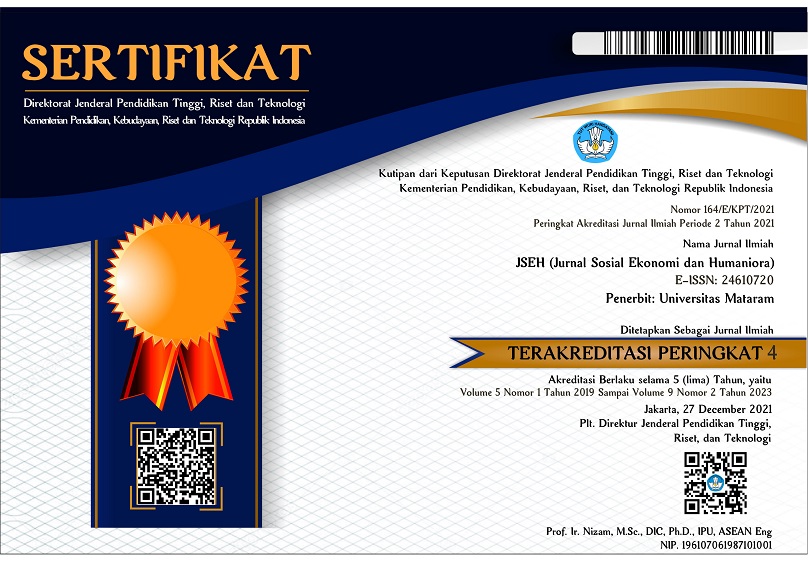Integration of Indonesian Stock Market With Stock Market of The Highest Economic Countries
DOI:
https://doi.org/10.29303/jseh.v10i4.727Keywords:
Co-Integration, Co-movement, stock marketAbstract
This study aims to analyze the integration between the Indonesian stock market and the stock markets of the world's leading economies, including the United States, China, Japan, Germany, France, India, and Brazil. The approach employed is a quantitative one, using weekly data from 2016 to 2023, with a total of 418 observations. The analytical methods utilized are Johansen and Juselius co-integration to examine long-term integration and pair-wise Granger causality to assess short-term integration. The findings reveal no long-term integration between the Indonesian stock market and the stock markets of the world's leading economies. However, in the short term, the Indian stock market shows some degree of integration with the Indonesian stock market, while the stock markets of other countries do not exhibit such integration. This study contributes to the existing literature on stock market integration. Research on the integration of the Indonesian stock market with those of leading global economies remains limited, making this study an important reference. The findings provide valuable insights for both Indonesian investors and those from leading economies in formulating strategies for international portfolio diversification.
References
Al Nasser, O. M., & Hajilee, M. (2016). Integration of emerging stock markets with global stock markets. Research in International Business and Finance, 36, 1–12. https://doi.org/https://doi.org/10.1016/j.ribaf.2015.09.025
Alvi, M. A., & Chughtai, S. H. (2014). Co-Movement of Pakistan Stock Market with the Stock Markets of Major Developed Countries Which Have Portfolio Investment in Pakistan. European Journal of Business and Management, 6(34).
Baele, L., Ferrando, A., Hördahl, P., Krylova, E., & Monnet, C. (2004). Measuring Financial Integration In The Euro Area (No. 14).
Barus, A. (1997). An investigation of the dynamic behavior and characteristics of Indonesian capital markets. University of New Orleans.
Bekaert, G., & Harvey, C. R. (1997). Emerging equity market volatility. Journal of Financial Economics, 43(1), 29–77. https://doi.org/https://doi.org/10.1016/S0304-405X(96)00889-6
Bekaert, G., & Mehl, A. (2019). On the global financial market integration “swoosh” and the trilemma. Journal of International Money and Finance, 94, 227–245.
Boamah, N. A. (2022). Segmentation, business environment and global informational efficiency of emerging financial markets. The Quarterly Review of Economics and Finance, 84, 52–60.
Bodie, Z., Kane, A., & Marcus, A. J. (2014). Investment. McGraw-Hill Education.
Boubakri, S., & Guillaumin, C. (2015). Regional integration of the East Asian stock markets: An empirical assessment. Journal of International Money and Finance, 57, 136–160. https://doi.org/https://doi.org/10.1016/j.jimonfin.2015.07.011
Calvi, R. (2010). Assessing financial integration: acomparison between Europe and East Asia.
Chen, Y., Li, T., Zeng, Q., & Zhu, B. (2023). Effect of ESG performance on the cost of equity capital: Evidence from China. International Review of Economics & Finance, 83, 348–364.
Dickey, D. A., & Fuller, W. A. (1979). Distribution of the Estimators for Autoregressive Time Series With a Unit Root. Journal of the American Statistical Association, 74(5), 427–431.
Dunis, C. L., & Shanon, G. (2005). Emerging markets of South-East and Central Asia: Do they still offer a diversification benefit? Journal of Asset Management, 6, 168–190.
Errunza, V., & Losq, E. (1995). International Asset Pricing under Mild Segmentation: Theory and Test. The Journal of Finance, 40(1), 105–124.
Fabian, H. (2022). Local, regional, or global asset pricing? Journal of Financial and Quantitative Analysis, 57, 291–320.
Forbes, K. J., & Rigobon, R. (2002). No Contagion, Only Interdependence: Measuring Stock Market Comovements. The Journal of Finance, 57(5), 2223–2261.
Gupta, H. (2019). Integration of Stock Market – Evidence from India and Major Global Indices. International Journal of Financial Management, 9(1), 16–26.
Haddad, S. (2023). Global Financial Market Integration: A Literature Survey. Journal of Risk Financial Managment, 16(12), 494. https://doi.org/DOI:10.3390/jrfm16120495
Ibrahim, M. H. (2000). Cointegration and Granger Causality Tests of Stock Price and Exchange Rate Interactions in Malaysia. ASEAN Economic Bulletin, 17(1), 36–47.
Irandoust, M. (2021). FDI and financial development: evidence from eight post-communist countries. Studies in Economics and Econometrics, 45(2), 102–116.
Lee, S., Chung, C. Y., & Ullah, F. (2024). Integration of Pakistan’s stock market with the stock markets of top ten developed economies. Heliyon, 10(5), e26542.
Lukanima, B. K., Barrios, L. J. S., & Bravo, Y. P. G. (2024). Towards understanding MILA stock markets integration beyond MILA: New evidence between the pre-Global financial crisis and the COVID19 periods. International Review of Economics & Finance, 84(A), 478–497.
Markowitz, H. (1952). Portfolio selection. The Journal of Finance, 7(1), 77–91. https://doi.org/https://doi.org/10.1111/j.1540-6261.1952.tb01525.x
Mishra, P. K., & Mishra, S. K. (2022). Is the Impact of COVID-19 Significant in Determining Equity Market Integration? Insights from BRICS Economies. Global Journal of Emerging Market Economies, 14, 137–262.
Mobarek, A., Muradoglu, G., Mollah, S., & Hou, A. J. (2016). Determinants of Time Varying Co-movements among International Stock Markets during Crisis and Non-crisis periods. Journal of Financial Stability, 24, 1–11.
Nguyen, T. D., & Elisabeta, P. (2016). Financial integration and diversification benefits: China and ASEAN4 countries. Managerial Finance, 42(5), 496–514. https://doi.org/https://doi.org/10.1108/MF-12-2014-0300
Obstfeld, M. (1994). Risk-Taking, Global Diversification, and Growth. American Economic Review, 84(5), 1310–1329. https://doi.org/http://www.jstor.org/stable/2117774.
Palac-McMiken, E. D. (1997). An examination of ASEAN stock markets: a cointegration approach. ASEAN Economic Bulletin, 13(3), 299–311. https://doi.org/DOI:10.1355/AE13-3B
Qian, L., Jiang, Y., & Long, H. (2023). What drives the dependence between the Chinese and interna-tional stock markets? Modern Finance, 1(1), 12–16.
Schwarz, G. (1978). Estimating the Dimension of a Model. The Annals of Statistics, 6(2), 461–464.
Singh, K., Singh, A., & Prakash, P. (2022). Estimating the cost of equity for the regulated energy and infrastructure sectors in India. Utilities Policy, 74, 101327.
Stehle, R. (1997). An Empirical Test Of The Alternative Hypotheses Of National And International Pricing Of Risky Assets. The Journal of Finance, 32(2), 493–502.
Tesar, L. L. (1991). Savings, investment and international capital flows. Journal of International Economics, 31(2), 55–78. https://doi.org/https://doi.org/10.1111/j.1540-6261.1977.tb03287.x
Wang, N., & You, W. (2023). New insights into the role of global factors in BRICS stock markets: A quantile cointegration approach. Economic Systems, 47(2), 101015.
Wu, F. (2020). Stock market integration in East and Southeast Asia: The role of global factors. International Review of Financial Analysis, 67, 101416. https://doi.org/https://doi.org/10.1016/j.irfa.2019.101416
Downloads
Published
How to Cite
Issue
Section
License
Copyright (c) 2024 Sahdan Saputra, Wira Hendri

This work is licensed under a Creative Commons Attribution-NonCommercial 4.0 International License.







